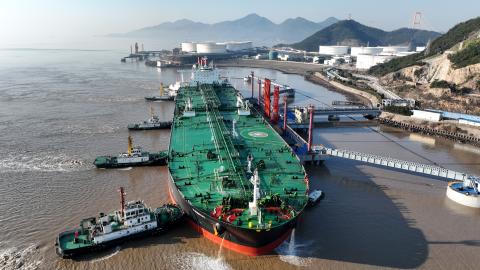As Chinese forces brush back U.S. ships and planes in international waters, concerns about war over Taiwan rise. For decades, free-world leaders banked on two advantages to deter China: its military weakness and its economic Achilles’ heel, a dependence on Middle Eastern energy that could be interdicted in a crisis. Now both advantages are fading, and their fate is interconnected.
Decades-long increases in Chinese military capabilities have undermined, if not erased, America’s once-clear military superiority. Less noted, but also worrisome, are China’s steady efforts to reduce its energy vulnerability. Western analysts should take heed.
In normal times, China uses roughly 16 million barrels per day (mbd) of crude oil. Of this, it imports up to 12 mbd. Half of these imports come from the greater Middle East, crossing the Indian Ocean and Southeast Asian straits. In short, overseas oil remains China’s lifeblood, and in wartime, the democracies could disrupt its transit.
Aware of this danger, the Chinese Communist Party has long prioritized a two-pronged response. First, its military strategy calls for a “short, sharp” war, seeking victory before energy shortages cripple China. Second, its energy strategy seeks to secure oil sufficient for months of war.
The CCP has launched several major efforts to secure such energy supplies. It has tried, but largely failed, to dramatically ramp up domestic crude production. It has promoted electric-powered vehicles using coal-generated power. And most importantly, it has increased the size of China’s strategic petroleum reserves and secured overland oil-supply lines from Russia, an oil superpower.
The CCP obfuscates its energy data, so it’s hard to know for sure. But combined, these measures may provide China with several months’ or more worth of reliable energy during a crisis.
For years, the CCP has prioritized building and filling a strategic petroleum reserve. China launched SPR construction in 2007 and completed its first of three phases by 2009, setting a goal of 90 days’ worth of imports by 2020. By 2019, authorities announced that China had 80 days of forward cover in aboveground and underground facilities. Since then, and particularly during Covid shutdowns when oil prices dropped, China has accelerated its SPR-building efforts.
By some recent estimates, China’s government-controlled stockpiles cover 100 to 120 days’ worth of peacetime imports, exceeding international authorities’ recommendations for peacetime buffers. China’s national-security concerns make even greater increases likely.
In addition, China has increased access to Russian crude oil, which, unlike seaborne imports, can be piped or carried directly into the country. Russia’s isolation after invading Ukraine has increased China’s leverage. Russian oil-pipeline capacity approaches 2 mbd, but oil can also move into China by rail, barges, and trucks. In the 2010s, when combined Canadian and Bakken crude-oil production exceeded pipeline capacity, the U.S. moved over 1 mbd by rail. Through such measures, China could receive as much or more overland oil from Russia.
Notably, despite international sanctions over Ukraine, Russian crude-oil production has remained resilient, confounding OPEC and analysts’ expectations. Such unexpected production may be passing into storage for future Chinese use.
Then, too, China might stretch its wartime reserves by cutting non-military uses. China’s Covid shutdowns have taught it how to control domestic demand.
In short, while China guards its secrets, experts’ analysis supports assessments that its reliable supply in a crisis might exceed four months’ worth of imports.
How would months of energy resilience compare to the length of the “short, sharp war” at which China’s President Xi Jinping aims? Xi covets Taiwan, but he must gauge as well a war’s unpredictable risks. Perhaps Putin’s unexpected floundering in Ukraine has given him pause.
But Ukraine has also highlighted American weaknesses. America has limited weapons inventories and a limited ability to replenish them. By some estimates, America would run out of missiles and ammunition within weeks of a Chinese invasion of Taiwan. Washington recoiled from risking American forces in Ukraine, while America’s Pacific forces would suffer greatly in a war with China. Finally, fear of an escalation to nuclear war has handcuffed the American response in Ukraine and might do so as well in Taiwan. For example, firing missiles deep into a nuclear power’s interior to attack oil-storage facilities and pipelines entails escalation risks from which the U.S. may shirk.
All these factors might lead China to expect that America might embrace an early ceasefire if war broke out, and that a worried world would press for one. Xi might perceive the short, sharp war he seeks as within reach.
Ukraine may influence Xi’s judgment of longer-run costs, too. Many nations abjured sanctioning Russia, while America’s sanctions have been porous. Given China’s greater economic heft, Xi may see the post-war international costs of attacking Taiwan, not a widely recognized nation, as manageable, and even an inconclusive but quick war as a step toward ultimate success.
In sum, the military and energy pictures are shifting. Strategic reserves, Russian imports, and domestic controls have provided China with an energy buffer. Chinese energy vulnerability, once taken as a given by Western analysts, may no longer drive Xi’s calculations. He may well see weapons inventories and the military balance as the more important factor in his decision-making.
There are many sound reasons for Xi to avoid a war over Taiwan. But as China’s energy resilience strengthens, so does the temptation to start one. The first arrows, at least, may not pierce this Achilles’ heel.

















